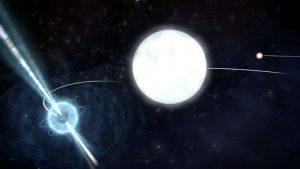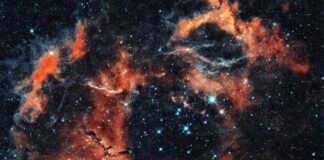JULY 8, 2018

In a new test, an international team of researchers has shown Einstein’s theory of general relativity or GR holds true even in the most extreme environments prevailing in the known universe.
Proposed more than a century ago, the famous theory from the physicist states all objects fall at the same rate, be it a feather or a cannonball.
The idea, scientifically called the equivalence principle, has been tried and validated on a number of occasions on Earth. Apollo 15 astronaut David Scott even demonstrated it on the moon after dropping a hammer and feather at the same time and showing they both hit the lunar dirt at the same time, regardless of how big they are or what they are made of.
However, there have been contradictions to the idea as some people have suggested alternative theories of gravity might be applicable in the cases of most dense or massive objects with extreme gravity.
As a neutron star — an object of very small radius (typically 30 km) and high density — carries extremely strong self-gravitation and makes the right candidate for the test equivalence principle, the international research team looked at a unique three-star system consisting a neutron star and two white dwarfs — stellar bodies that are just as big as Earth but carry the sun’s mass.
The system, sitting 4,200 light years away from us, was first discovered in 2011. However, follow-up observations confirmed the closely orbiting neutron star and white dwarf, and the second white dwarf orbiting the pair much further away is an appropriate set-up to see how the gravity of the outer star affects those on the inside.
“This is a unique star system,” Ryan Lynch, a co-author on the paper, said in a statement. “We don’t know of any others quite like it. That makes it a one-of-a-kind laboratory for putting Einstein’s theories to the test.”
They took more than 800 observations of the star system from Green Bank Telescope in West Virginia, the Arecibo Observatory in Puerto Rico, and the Westerbork Synthesis Radio Telescope in the Netherlands. The findings of the work conducted over a six-year-long period revealed both inner stars — the neutron star and the white dwarf — accelerated at very similar pace, just like the hammer and feather.
This, as the researchers described, not just rules out alternative theories of gravity but is also a 10 times more precise test than the best experiments conducted ever before.
“If there is a difference, it is no more than three parts in a million,” Nina Gusinskaia, co-author of the study, said in another statement. “Now, anyone with an alternative theory of gravity has an even narrower range of possibilities that their theory has to fit into, in order to match what we have seen.”
The study titled, “Universality of free fall from the orbital motion of a pulsar in a stellar triple system,” was published July 4 in the journal Nature.
Courtesy/Source: IBT











































































































